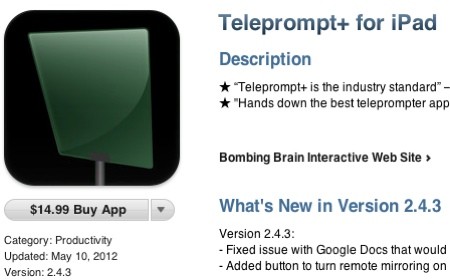
A few developers have talked before about the App Store’s “race to the bottom” problem, and Joe Cieplinski has clearly been doing some thinking about the issue as well. In his talk at 360iDev this week, Cieplinski (who is a former English teacher and Apple Store employee, and now works as a designer for Bombing Brain Interactive, which makes an app called Teleprompt+ for iPad) pointed out that back in the early days of the App Store, some developers decided to try and price their apps at Apple’s lowest option of 99 cents (“I didn’t get an email,” he joked, “Were you guys consulted?”).
A few of those 99 cent apps made millions of dollars, and Cieplinski says that other iOS developers wrongly decided that “99 cents must be the reason” for that success. As a result, 99 cents has become the standard for most App Store apps, with many other apps moving even lower down to free. At this rate, Cieplinski joked again, developers will soon be paying people to install their apps, and indeed, he said, that’s already happening.
So how can we fix this? Cieplinski says that most of the apps being sold for just 99 cents on the App Store are worth more than that, but “customers have been condition to think this is what your app is worth,” and many developers are worried that if they move up to a higher price point, their users will revolt completely. But Cieplinski is also convinced that what’s commonly called a “premium price” should instead be called a “fair price.” Developers shouldn’t be ashamed to charge customers what their apps (assuming the quality is high) are worth.
Apple set this tone when the iPad arrived, said Cieplinski. When the iWork apps first appeared, they were priced at $9.99 each, and not only have those sold like gangbusters for Apple, but the pricing on those apps is meant to serve as a message to developers from Cupertino: “You can charge more than 99 cents,” Cieplinski said. “Start doing it.”
He should know, too — Teleprompt+ was released at a price of $9.99, and while Cieplinski calls early sales “modest,” he said they actually increased over time. Most freemium and 99 cent apps see a large sales spike at release and then fall off precipitously, but Teleprompt+ saw a different curve, one that raised slowly but surely as time went on. So much so, in fact, that when Bombing Brain updated the app to version 2.0 with a significant redesign and new features, they raised the price to $14.99. And the real kicker: They saw sales increase.
Now, this likely won’t work for all developers — Cieplinski points out that if you’re going to charge more for an app, it better be a really great app, and you better have the resources (or at least be willing to put in the work) to do things like market your app to the right audience, provide flawless and responsive tech support, and update your app “early and often,” making sure that it provides a lot of value to its users. But if developers are able to do this, they can not only charge a premium price, but they can demand a premium customer. Customers that buy apps at higher prices, said Cieplinski, are big seekers of value, and are willing to really use and become dedicated to the apps they invest in. If someone spends $9.99 on an app, they’re more likely to use it again and again, and eventually love it so much so that they recommend it to everyone they know.
Cieplinski’s points are intriguing. It’s hard to see the 99 cent price disappear from the store entirely — there are definitely developers out there (and apps) that are meant to be more impulse purchases and relatively throwaway thrills. And there will always be developers ready to undercut their colleagues, in order to simply grab the largest audience possible. But Cieplinski did his best to prove that there is a market for “fair priced” apps on the App Store, and that developers willing to charge more for apps that are worth it will be able to reap higher rewards as well.
360iDev: The case for ‘fair pricing’ on iOS apps originally appeared on TUAW – The Unofficial Apple Weblog on Wed, 12 Sep 2012 00:00:00 EST. Please see our terms for use of feeds.
Source